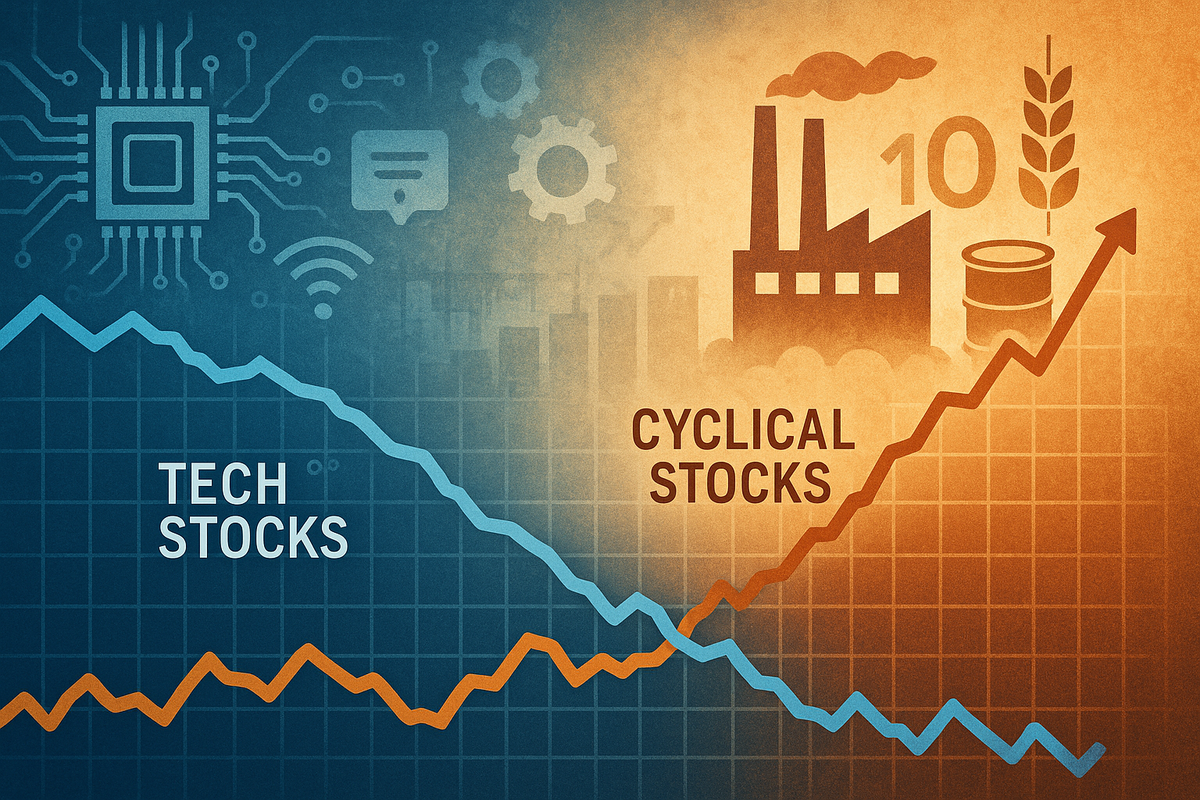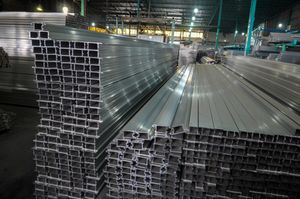
On August 14, 2025, the financial markets witnessed a significant sector rotation as investors recalibrated their portfolios, shifting away from the high-flying growth-oriented technology stocks towards more economically sensitive cyclical sectors. This strategic pivot, occurring amidst a broader market rally that saw both the Nasdaq Composite and S&P 500 reach new closing highs, signals a nuanced evolution in investor sentiment and a potential redefinition of market leadership. The immediate implications suggest a more diversified and potentially resilient market, but also raise questions about the sustainability of the tech sector's dominance.
This notable churn reflects a complex interplay of macroeconomic signals, corporate earnings, and evolving investor strategies. While the overall market displayed renewed confidence, the underlying currents indicate a cautious optimism, with market participants seeking value and stability in sectors poised to benefit from anticipated economic shifts.
A Strategic Reallocation: What Happened and Why It Matters
The sector rotation on August 14th was primarily driven by a confluence of factors, most notably the heightened anticipation of the Federal Reserve's first interest rate cut of 2025 in September. This optimism was fueled by weaker-than-anticipated job additions over the past three months and moderate inflation data for July, with the CME FedWatch tool indicating a 100% probability of a 25-basis-point rate cut. Such a move would typically favor cyclical stocks, which tend to perform well in environments of lower borrowing costs and economic expansion.
Adding to the complexity, the release of the U.S. Producer Price Index (PPI) data, which surged 0.9% in August 2025 (exceeding the 0.2% forecast), introduced a layer of uncertainty regarding persistent inflationary pressures. This data point, while seemingly contradictory to rate cut hopes, prompted investors to re-evaluate their sector strategies, seeking out industries with stronger pricing power and less sensitivity to potential economic headwinds. Furthermore, robust second-quarter earnings results across various sectors boosted overall investor confidence, encouraging a broader allocation of capital beyond the concentrated "Magnificent 7" technology stocks.
There was also a discernible "Magnificent 7" fatigue among investors. These mega-cap technology companies, including giants like Apple (NASDAQ: AAPL) and Nvidia (NASDAQ: NVDA), had largely propelled market gains in 2023-2024. However, signs of saturation and a desire for diversification led investors to "spread out from the artificial intelligence trade," a development viewed by some analysts as an "extraordinarily bullish sign for all indices" as it suggests a healthier, broader market participation. Additionally, some large funds engaged in a "defensive rotation," moving into sectors with more stable earnings as a precautionary measure for potentially choppier market conditions in the fourth quarter. This strategic shift underscores a growing emphasis on resilience and diversification in portfolio construction.
The immediate implications of this sector churn were multifaceted. While the tech-heavy Nasdaq Composite still managed a modest 0.1% gain, its relative underperformance signaled a potential shift in market leadership. Conversely, cyclical sectors experienced significant gains. The Materials Select Sector SPDR (NYSEARCA: XLB), Health Care Select Sector SPDR (NYSEARCA: XLV), Energy Select Sector SPDR (NYSEARCA: XLE), and Consumer Discretionary Select Sector SPDR (NYSEARCA: XLY) all saw rises. Small-cap stocks, as represented by the Russell 2000 index, performed particularly well, indicating a shift towards companies more sensitive to the domestic economy. Defensive sectors like Insurance and Utilities also gained traction, appealing to investors seeking stability due to their strong pricing power, exposure to rising interest rates, and stable cash flows. The Aerospace & Defense sector emerged as a standout cyclical play, supported by increased defense spending. This broad-based rally, despite the underlying rotation, signals a "risk-on" environment and growing confidence in the economic outlook, anticipating sustained growth driven by accommodative monetary policies and strong corporate performance.
Winners and Losers in the Sector Shuffle
The recent market shift has created a clear delineation between potential winners and losers, reshaping the investment landscape. Cyclical stocks, intrinsically linked to the broader economic cycle, are poised to benefit significantly. Companies in the Financials sector, such as JPMorgan Chase (NYSE: JPM), are expected to thrive. An economic upswing typically translates to increased loan demand, improved credit quality, and potentially higher interest rates, all of which bolster net interest margins for banks. Furthermore, investment banking fees and trading revenues tend to rebound with improved market conditions and increased deal-making activity.
Industrials, encompassing manufacturing, construction, and transportation, are also set to gain. Companies like U.S. Steel Corp. (NYSE: X) and railroad giants such as Canadian Pacific Kansas City Limited (NYSE: CP) will likely see increased demand for manufactured goods, infrastructure projects, and transportation services as economic activity accelerates. The Materials sector, providing raw materials for various industries, will similarly benefit from heightened manufacturing and construction. Energy companies, including those in oil and gas, are also positioned for growth as economic expansion often correlates with higher energy demand and commodity prices.
Conversely, high-growth technology stocks, particularly those with elevated valuations, are likely to face headwinds. While not a complete exodus, the rotation suggests a re-evaluation of their "premium myth." Companies like Apple (NASDAQ: AAPL) and Nvidia (NASDAQ: NVDA), while still formidable, saw marginal declines on August 14th, indicating a tempering of investor enthusiasm for their previously unbridled growth. The shift away from "AI-driven memory stocks" towards more traditional, cyclical memory products like DRAM and NAND could impact companies heavily invested in these high-growth segments.
The impact on these companies is direct. Winners in the cyclical rotation are expected to see increased revenue and profitability, driven by higher demand for their products and services. This will likely lead to improved investor sentiment, higher stock prices, and a potential re-rating of their valuations. For tech companies, the scenario is reversed. They may experience stock price declines as investors reallocate capital, a contraction in their valuations, and reduced investor appetite. Companies that have prioritized growth over immediate profitability may face increased scrutiny, as the market now prioritizes more stable and economically sensitive earnings.
Industry Impact and Broader Implications
This sector rotation on August 14th is not an isolated event but rather fits into broader industry trends signaling a maturing market cycle and a recalibration of investor expectations. For years, technology stocks, particularly the "Magnificent 7," have been the primary drivers of market gains, fueled by innovation, low interest rates, and a seemingly insatiable demand for digital transformation. However, as interest rates are poised to normalize and economic growth becomes more broad-based, the market is naturally seeking out value in sectors that have historically been overlooked.
The potential ripple effects on competitors and partners are significant. In the tech sector, companies that are heavily reliant on discretionary consumer spending or have less diversified revenue streams may face increased pressure. Conversely, tech companies that provide essential services or have strong enterprise contracts might prove more resilient. For cyclical industries, this shift presents an opportunity for renewed investment and expansion. For example, increased demand for materials and industrial goods could lead to higher capital expenditures and job creation in these sectors.
From a regulatory and policy perspective, this rotation could influence future discussions. If cyclical sectors continue to gain prominence, there might be increased focus on infrastructure spending, industrial policy, and regulations impacting traditional industries. Conversely, the tech sector might face continued scrutiny regarding market concentration and antitrust concerns, especially if their dominance is perceived to be waning.
Historically, such rotations are not uncommon. Periods of rapid technological advancement are often followed by phases where investors seek more stable, value-oriented investments as the broader economy catches up. The dot-com bubble burst in the early 2000s serves as a stark reminder of how quickly market leadership can shift when valuations become detached from fundamentals. While the current situation is not as extreme, the underlying principle remains: a healthy market requires diversification and a balance between growth and value. This current rotation suggests a return to more traditional market dynamics, where economic fundamentals play a more prominent role in sector performance.
What Comes Next
The immediate future will likely see continued volatility as the market digests the implications of this sector rotation. In the short term, investors should anticipate further rebalancing of portfolios, with a continued flow of capital into cyclical and defensive sectors. This could lead to sustained upward momentum for industries like financials, industrials, and materials, while the tech sector might experience a period of consolidation or even a slight pullback as investors lock in profits and re-evaluate growth prospects.
In the long term, this shift could signify a more balanced market, less reliant on a handful of mega-cap tech companies. This could lead to a broader distribution of gains across various sectors, potentially fostering a more resilient and diversified economy. Companies in cyclical industries will need to strategically pivot to capitalize on increased demand, potentially investing in capacity expansion, technological upgrades, and workforce development. For tech companies, the challenge will be to demonstrate sustainable profitability and diversified revenue streams beyond their core growth narratives.
Market opportunities may emerge in undervalued cyclical stocks that have been overlooked during the tech boom. Conversely, challenges may arise for tech companies that fail to adapt to a more discerning market, potentially leading to increased competition and pressure on profit margins. Potential scenarios include a sustained cyclical rally if economic growth remains robust and interest rates stabilize, or a more volatile environment if inflation proves persistent or global economic uncertainties escalate. Investors should closely monitor inflation data, Federal Reserve policy statements, and corporate earnings reports from both tech and cyclical sectors to gauge the market's direction.
Conclusion
The sector rotation observed on August 14th represents a significant recalibration of investor sentiment, marking a pivot from the long-standing dominance of technology stocks towards more economically sensitive cyclical sectors. The key takeaway is a market that is seeking broader participation and a more balanced allocation of capital, driven by expectations of interest rate cuts and a desire for diversification beyond the "Magnificent 7."
Moving forward, the market is likely to exhibit a more diversified leadership, with cyclical industries playing an increasingly prominent role. This shift underscores the importance of a balanced portfolio that combines the resilience of defensive sectors with the growth potential of certain cyclical industries. Investors should closely watch for continued signs of economic growth, inflation trends, and the Federal Reserve's monetary policy decisions, as these will be crucial in shaping the market's trajectory in the coming months. The lasting impact of this rotation could be a more mature and fundamentally driven market, where value and economic sensitivity regain prominence alongside innovation and growth.


















